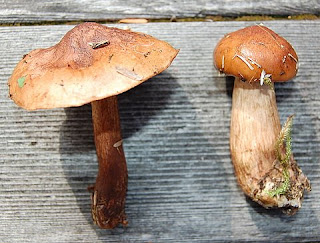September 27
Julie Roller and I bypassed the two sunny days this week and choose the first rainy day to head up Harbor Gavan to collect seeds. We met around 2pm at Crescent harbor and Julie drove up the mountain. Happy that I brought all my rain gear, but wished I had brought the more serious rain coat.
The weather was merely wet when we started up the trail, wet enough though that we put our raingear on in the cab of her small truck. We were on our way to the meadows of the boulder field where the plants we searching might have ripe seeds. Most of the way along the ridge before the signpost marking the fork we could see the ocean and the surrounding peaks. This changed somewhere before we reached our destination, in fact the rain was intense and rather icy feeling. We passed only one group of fellow hikers (or people with bad timing) along the ridge.
I looked at the hourly weather records for the afternoon taken at sea level, I assume at the airport. They show a nice deterioration in conditions during our hike, but don't really give much of the feel of the wind driven rain in our faces.
1:53: 52F, 74% humidity, 9 miles visibility, winds from the SE at 9.2 miles no rain
2:41: 51 F, 83% humidity, 7 miles visibility, winds from the SE at 9.2 miles, 0.02 rain
2:53: 51, 83% humidity, 6 miles visibility, winds from SSE at 9.2 miles, 0.02 rain
3:53: 50, 87% humidity, 3 miles visibility, winds from SE at 11.5 miles, NA rain
4:22: 50 F, 94% humidty, 3 miles visibility, winds SE 11.5 (gust to 18.5), 0.05 rain
We started back around 4:00 or so just when the weather started to deteriorate nicely. It was easy enough to deal with on the way east, but I favored the head down push sort of posture on the way back to the trail head. The rain made it kind of difficult to use the binoculars that I had managed to bring this trip. Did see several Golden-crowned sparrows.
Both the Geum califolium and Cornus canadensis were a nice red color, the Athyrium was in places quite golden. The nicest micro view was of a patch of Gentiana platypetala blooming next to a patch of bright red Cornus. The only other flowers I saw in bloom were the Erigeron peregrinus and the very dissimilar Erigeron or former Aster. I did take a flower of each home with me. The flowers and leaves are quite dissimilar for purple daisy-like plants. The typical Erigeron has tidy looking heads with relatively short ray flowers. The margins of the leaves are smooth. The alternate daisy creature has larger heads with longer more irregular looking rays and toothed leaf margins. Both have similar looking subtending bracts that are quite hairy. I'm feeling fairly confident that it is Canadanthus modestus, but after all these years of everything being Erigeron, it is hard to shift gears.
I guess there was one Hiericium triste blooming as well.
Collected seeds from Veratrum viride, Anemone narcissifolium, Geranium erianthum, Saussurea perennis and Aconitum delphinifolium. Might try to get back for Gentiana seeds.
 She graciously provided the photos.
She graciously provided the photos. of Sheep island. A Sharp-shinned hawk was on the north point of the island, it flew to a tree on Galankin and unfortunately I lost sight of it. Also saw a Horned Grebe on the west side of the island.
of Sheep island. A Sharp-shinned hawk was on the north point of the island, it flew to a tree on Galankin and unfortunately I lost sight of it. Also saw a Horned Grebe on the west side of the island. 














































